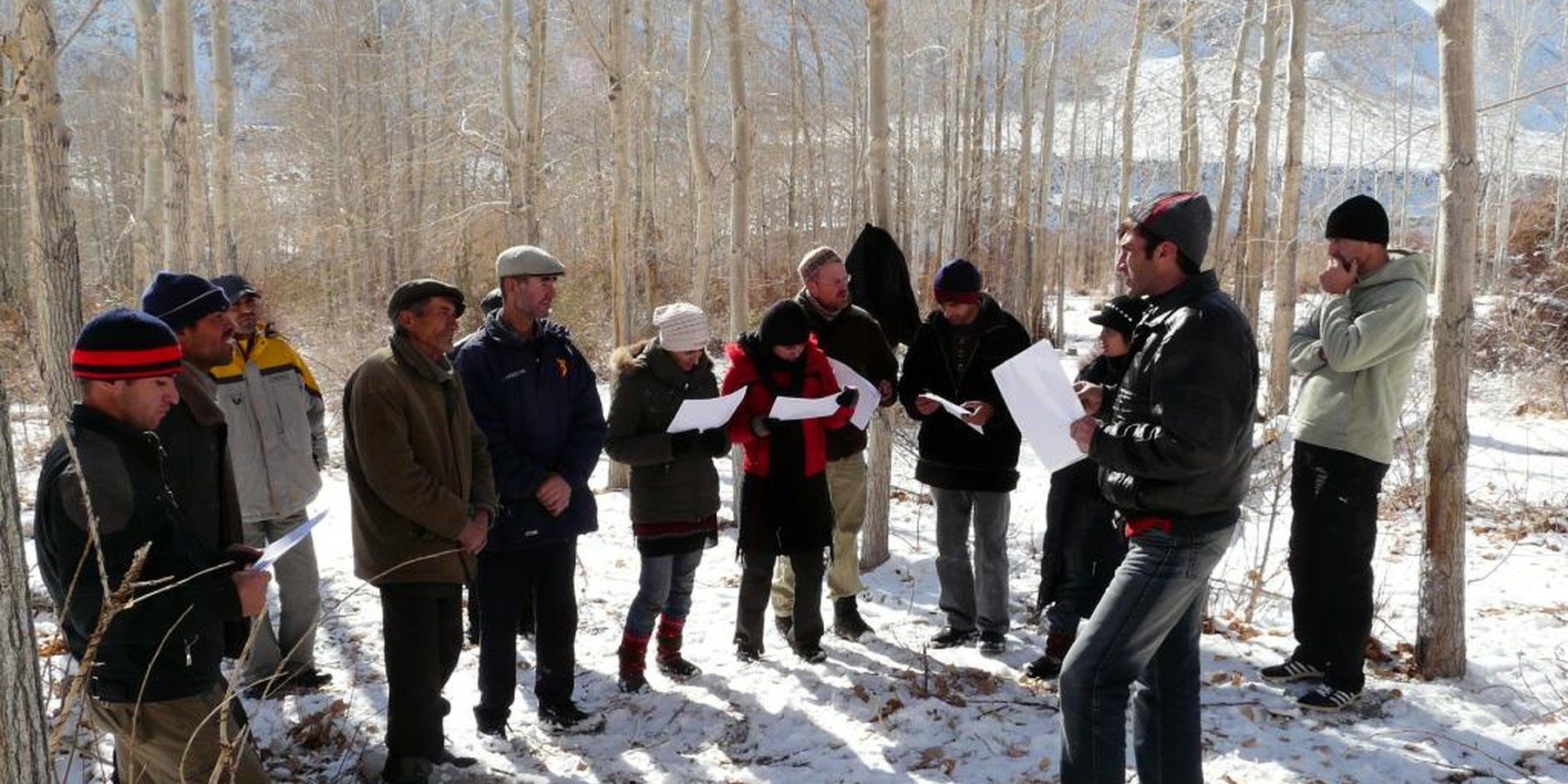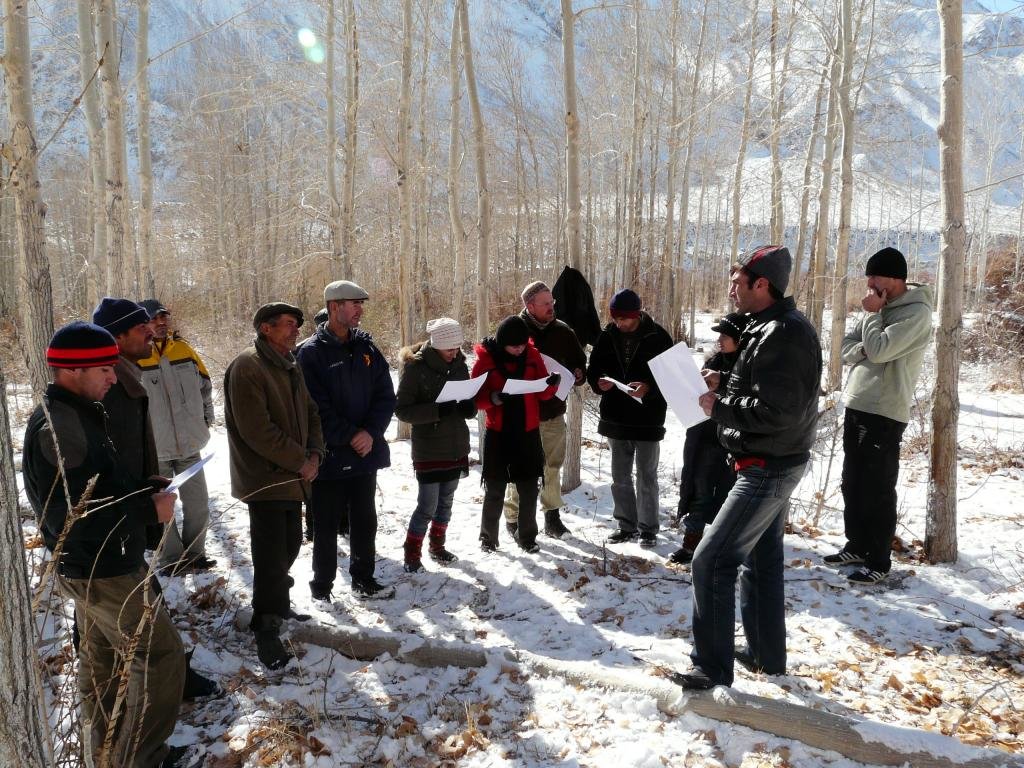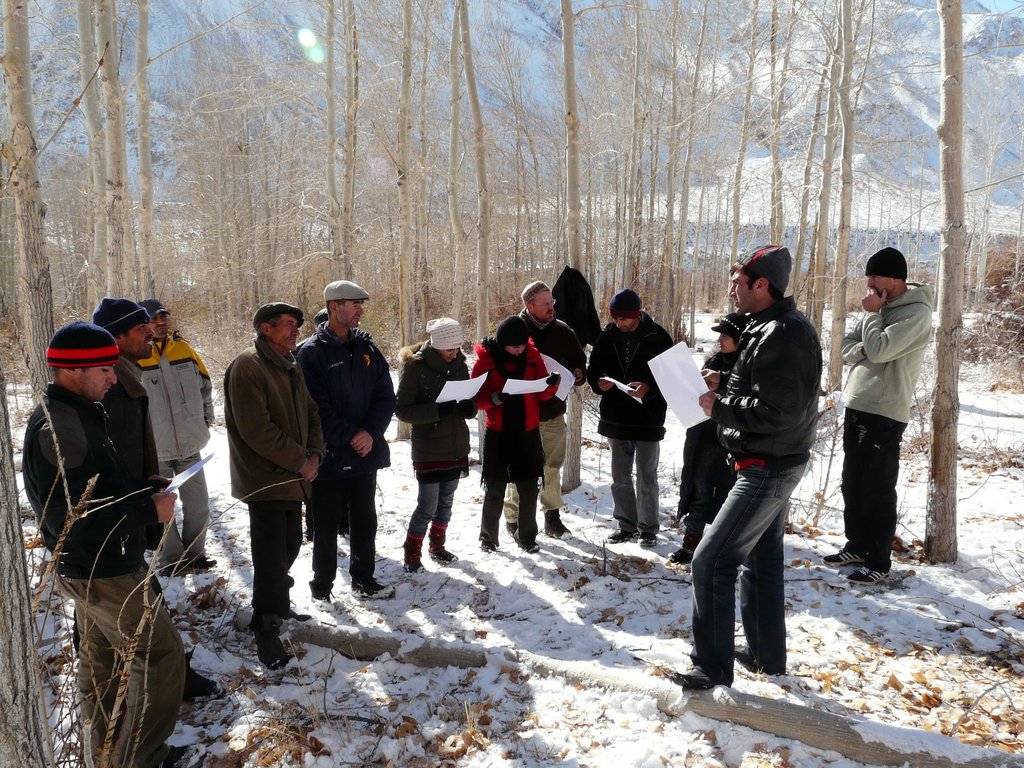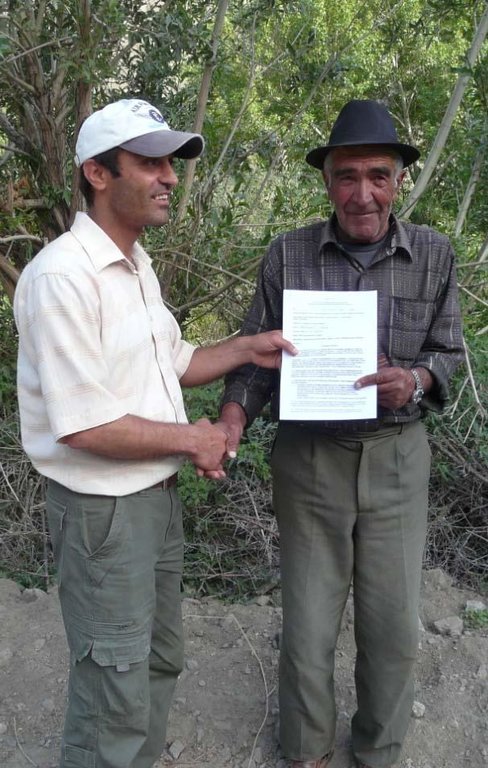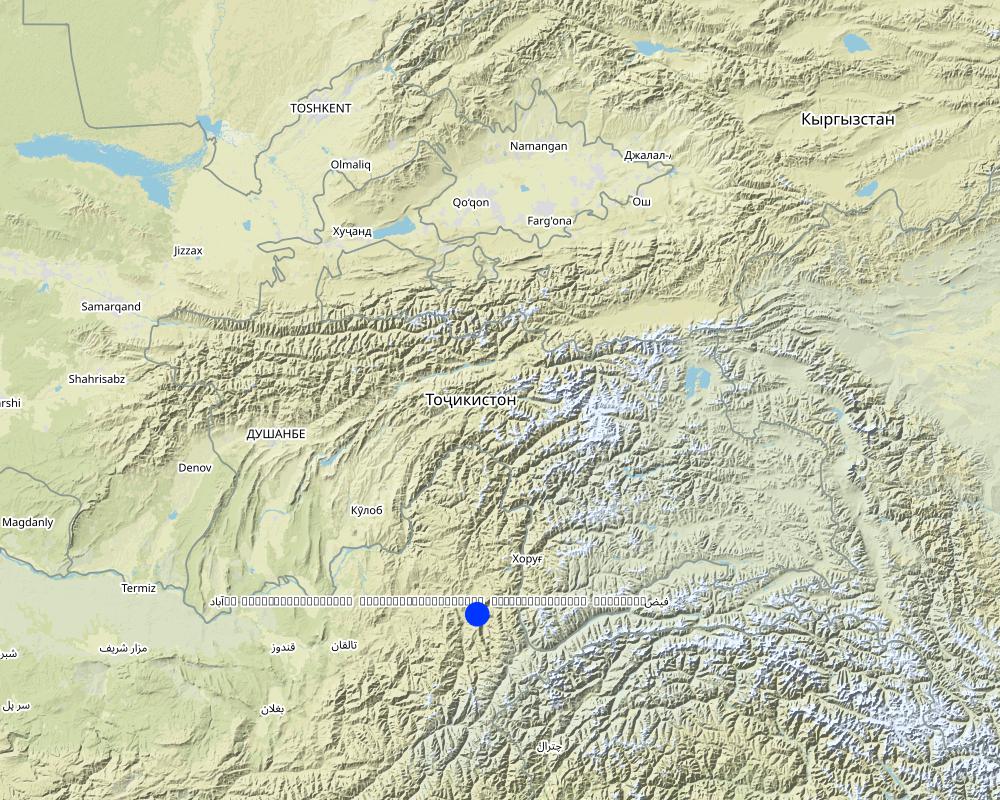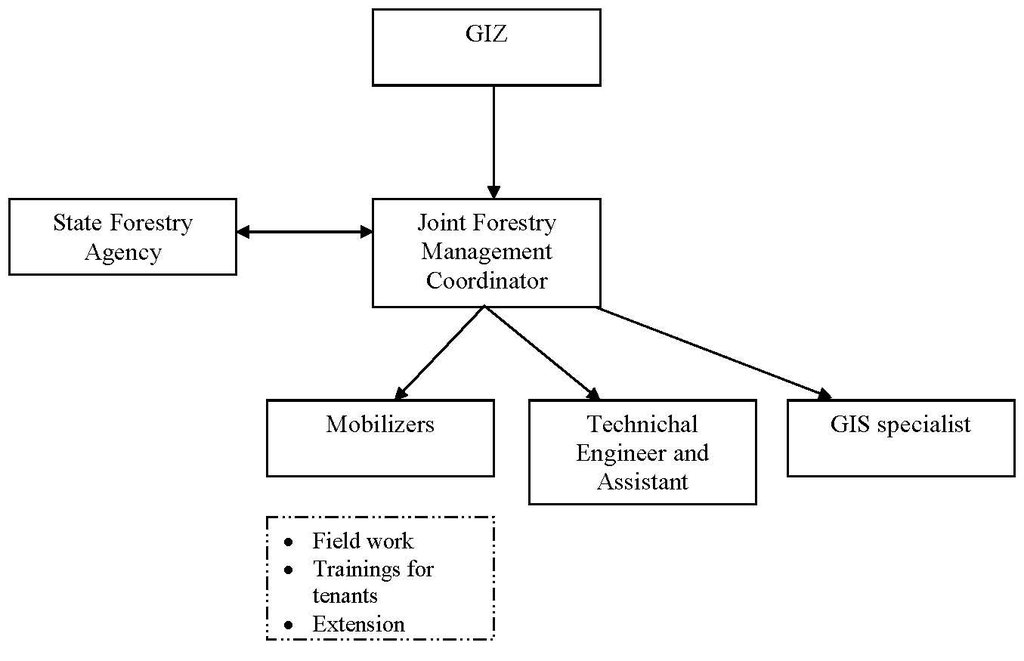Joint Forest Management (JFM) [Tadjikistan]
- Création :
- Mise à jour :
- Compilateur : Roziya Kirgizbekova
- Rédacteur : –
- Examinateurs : David Streiff, Alexandra Gavilano, Joana Eichenberger
Совместное управление лесами (СУЛ) (Russian)
approaches_2431 - Tadjikistan
Voir les sections
Développer tout Réduire tout1. Informations générales
1.2 Coordonnées des personnes-ressources et des institutions impliquées dans l'évaluation et la documentation de l'Approche
Spécialiste GDT:
Spécialiste GDT:
Angermann Michael
+992 935 747318
michael.angermann@giz.de
GIZ, Sustainable Management of Natural Resources in Gorno-Badakhshan
Okhonjon Str. 58-1, 736000 Khorog, Tajikistan
Allemagne
Spécialiste GDT:
Neusel Benjamin
+992 935 747312
benjamin.neusel@cimonline.de
GIZ, Sustainable Management of Natural Resources in Gorno-Badakhshan
Okhonjon Str. 58-1, 736000 Khorog, Tajikistan
Allemagne
Spécialiste GDT:
Kirchhoff Joachim F.
+992 44 6006702
joachim.kirchhoff@giz.de
GIZ, Regional Program on Sustainable Use of Natural Resources in Central Asia
Ayni Str./Nazarshoev Str., 734026 Dushanbe
Allemagne
Nom du projet qui a facilité la documentation/ l'évaluation de l'Approche (si pertinent)
Central Asian Countries Initiative for Land Management (CACILM I)Nom du projet qui a facilité la documentation/ l'évaluation de l'Approche (si pertinent)
Pilot Program for Climate Resilience, Tajikistan (WB / PPCR)Nom du ou des institutions qui ont facilité la documentation/ l'évaluation de l'Approche (si pertinent)
Deutsche Gesellschaft für Internationale Zusammenarbeit (GIZ) GmbH (GIZ) - Allemagne1.3 Conditions relatives à l'utilisation par WOCAT des données documentées
Quand les données ont-elles été compilées (sur le terrain)?
23/08/2009
Le compilateur et la(les) personne(s) ressource(s) acceptent les conditions relatives à l'utilisation par WOCAT des données documentées:
Oui
1.4 Références au(x) questionnaire(s) sur les Technologies de GDT
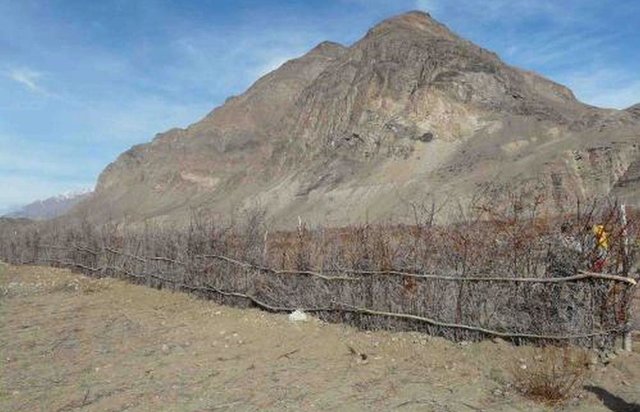
Establishment of living seabuckthorn fences for the protection … [Tadjikistan]
Protection of reforestation sites (willow, poplar and fruit trees) through living seabuckthorn perimeter fencing on Joint Forestry Management plots.
- Compilateur : Roziya Kirgizbekova
2. Description de l'Approche de GDT
2.1 Courte description de l'Approche
Protection and rehabilitation of state forests based on joint long term agreements set up between the State Forestry Agency, and local forest users (in the frame of CACILM).
2.2 Description détaillée de l'Approche
Description détaillée de l'Approche:
Aims / objectives: In Soviet times, the Gorno Badakhshan Autonomous Region (GBAO) had been highly dependent on subsidised fuel for heating and cooking. After independence, as fuel could no longer be imported from the former Soviet Union, more pressure was exerted on the flood plain forests, leading to severe degradation of the resources through illegal felling and livestock grazing. The State Forestry Agency does not have the financial means nor adequate capacity to implement a sustainable forestry management system adapted to the changed political, socio-economic and ecological conditions. The main aim of this approach is the rehabilitation of degraded floodplain forests in collaboration with the local users. This can only be achieved, if local users can see that they will benefit from conserving and developing the forest. Also, the State Forestry Agency is supported in its restructuring and gets an opportunity to achieve the protection of the forest, and economic goals through forest products and income from the rented forest plots.
Methods: \'Joint Forest Management\' (JFM) means that governmental organisations and local users are involved in forest management on the basis of a contract with a duration of 20 years, valid under Tajik law, which defines the rights and obligations of all the parties. As a first step, and in order to ensure the protection of the plot, a fence has to be built to protect reforestation activities from livestock (see Technology TAJ366). Adequate irrigation of the forest areas is also supported. Forest tenants as well as Forestry Agency staff are also trained in sustainable forest management techniques. Progresses and challenges are regularly being monitored and technical advice is being given to forest tenants.
Stages of implementation: The implementation includes eight steps: (1) field check and meeting with village representatives, (2) information workshop, (3) general agreement with the whole community, (4) selection of tenants, (5) division of the plots, (6) signing of contracts with the individual tenants, (7) elaboration of management plans and annual plans for each tenant, and (8) monitoring of annual plans.
Role of stakeholders: The annual plan is based on a 5-year management plan for the respective plot. It determines the amount of work undertaken by the forest tenant as well as harvests and their shares to be obtained from the rented area in one year. The rental contract, the management plan, and the annual plan are mutually agreed on by the forest tenants and the Forestry Agency. Forest tenants develop a sense of ownership and responsibility for the sustainable use of forests and forest resources on their plot. The State Forestry Agency is responsible for control and technical advice.
2.3 Photos de l'approche
2.5 Pays/ région/ lieux où l'Approche a été appliquée
Pays:
Tadjikistan
Région/ Etat/ Province:
Tajikistan Gorno Badakhshan Autonomous Region (GBAO)
Autres spécifications du lieu :
Ishkashim, Roshtkala, Shugnan
Commentaires:
This approach is currently implemented in the districts of Shugnan, Roshtkala and Ishkashim in GBAO, and each year, the area covered is gradually increasing.
Map
×2.6 Dates de début et de fin de l'Approche
Indiquez l'année de démarrage:
2009
2.7 Type d'Approche
- fondé sur un projet/ programme
2.8 Principaux objectifs de l'Approche
The Approach focused mainly on SLM with other activities (Income generation, income diversification, forest rehabilitation, improved access to forest resources)
Protection and rehabilitation of state forests based on joint long term agreements set up between the State Forestry Agency, and local forest users.
The SLM Approach addressed the following problems: Limited management and control capacities of the State Forestry Agency, combined with a sudden increasing need for firewood resulted in an uncontrolled 'open access' situation in the floodplain forests of GBAO. People were using forest resources in an unsustainable manner, including uncontrolled felling and livestock pasture. This resulted in a large scale degradation of the floodplain forest resources.
2.9 Conditions favorisant ou entravant la mise en œuvre de la(des) Technologie(s) appliquée(s) sous l'Approche
disponibilité/ accès aux ressources et services financiers
- entrave
No funds available for the rehabilitation of irrigation infrastructure.
Treatment through the SLM Approach: Initial set up investments co-financed by international NGOs (GIZ).
cadre institutionnel
- entrave
No organisational structures for overall local management of rented state forests in place, including conflict solving mechanisms between stakeholders from different administrative levels.
Treatment through the SLM Approach: Establishment of Joint Forest Management council at local level.
cadre juridique (régime foncier, droits d'utilisation des terres et de l'eau)
- entrave
User rights for state forest were exclusively with the State Forestry Agency. Locals used the forests illegally.
Treatment through the SLM Approach: Contracts with individual tenants providing them with long-term user rights and responsibilities.
The existing land ownership, land use rights / water rights greatly hindered the approach implementation The forest land is in State property, the State Forestry Agency has exclusive user rights, however open access leads to uncontrolled use of forest resources by the local people. Restricting access can help create clear regulations, but these are not always accepted by villagers who prefer illegal open access to natural resources.
charge de travail, disponibilité de la main-d'œuvre
- entrave
After the collapse of the Soviet Union, the Forestry Agency had insufficient financial and human resources to manage the state forests.
Treatment through the SLM Approach: Responsibilities and workload are shared with the local population.
autre
- entrave
The State Forestry Agency lacks finances and capabilities to manage forest resources.
Treatment through the SLM Approach: Support of the Agency for internal reforms and the introduction of a sustainable forest management scheme (JFM).
3. Participation et rôles des parties prenantes impliquées dans l'Approche
3.1 Parties prenantes impliquées dans l'Approche et rôles
- exploitants locaux des terres / communautés locales
Women and men, rich and poor are involved equally
Actual implementation in close cooperation with the other bodies
- Spécialistes de la GDT/ conseillers agricoles
GIZ project staff and forest specialists
Supporting local users in implementing the Technology with some modifications.
The Approach has been designed by an international specialist, and some components by a local specialist
Conducting workshops, providing technical advice
- ONG
International non-government
Coordination and financing of the project, design of the approach
- gouvernement local
Support during implementation
Cooperation, approval of the legal framework
- gouvernement national (planificateurs, décideurs)
Support during implementation
Cooperation, approval of the legal framework
Si plusieurs parties prenantes sont impliquées, indiquez l'organisme chef de file ou l'institution responsable:
GIZ
3.2 Participation des exploitants locaux des terres/ communautés locales aux différentes phases de l'Approche
| Participation des exploitants locaux des terres/ communautés locales | Spécifiez qui était impliqué et décrivez les activités | |
|---|---|---|
| initiation/ motivation | interactive | Field visits, talks with village representatives, information seminar for the whole community. |
| planification | interactive | 5-year Management Plans and 1-year Annual Plans are developed for each forest plot, jointly by the land users and State Forestry Agency staff. |
| mise en œuvre | interactive | Live fence construction, irrigation rehabilitation, sharing of harvest. |
| suivi/ évaluation | interactive | Completed via the close cooperation between the State Forestry Agency and GIZ, using interviews completed by project mobilisers, as well as monitoring of annual achievements. |
| Research | aucun |
3.3 Diagramme/ organigramme (si disponible)
Description:
Organisational chart shows how the project staff work with the State Forestry Agency.
Auteur:
Sady Odinashoev (Tajikistan, Dushanbe)
3.4 Prises de décision pour la sélection de la Technologie/ des Technologies
Indiquez qui a décidé de la sélection de la Technologie/ des Technologies à mettre en œuvre:
- principalement les spécialistes de la GDT, après consultation des exploitants des terres
Expliquez:
The approach was developed and implemented in other geographical settings (South Asia) and adapted to the local conditions in GBAO. It is continuously being adapted, according to the practical experiences of SLM specialists and through consultation with the local forest tenants.
Decisions on the method of implementing the SLM Technology were made by mainly by land users supported by SLM specialists. GIZ project staff and forest specialists supported local users in implementing the Technology with some modifications.
4. Soutien technique, renforcement des capacités et gestion des connaissances
4.1 Renforcement des capacités/ formation
Une formation a-t-elle été dispensée aux exploitants des terres/ autres parties prenantes?
Oui
Spécifiez qui a été formé:
- exploitants des terres
- personnels/ conseillers de terrain
Si pertinent, spécifiez le genre, l'âge, le statut, l'ethnie, etc.
At first, so called 'community mobilisers' were trained, who further provided training for forest users.
Formats de la formation:
- sur le tas
- zones de démonstration
- réunions publiques
- cours
Thèmes abordés:
Sustainable natural resources management, technical forestry knowledge (planting, thinning) and elaboration of management plans.
4.2 Service de conseils
Les exploitants des terres ont-ils accès à un service de conseils?
Oui
Spécifiez si le service de conseils est fourni:
- dans les champs des exploitants?
Décrivez/ commentez:
Forestry training for tenants and forestry staff; Key elements: Sustainable natural resource management and use, Technical training in forestry management (planting and harvesting, fencing etc.)
Advisory service is quite adequate to ensure the continuation of land conservation activities; Government saw the good results gained from the Joint Forest Management approach, and is interested in continuing this approach.
4.3 Renforcement des institutions (développement organisationnel)
Des institutions ont elles été mises en place ou renforcées par le biais de l'Approche?
- oui, beaucoup
Spécifiez à quel(s) niveau(x), ces institutions ont été renforcées ou mises en place:
- local
Précisez le type de soutien:
- financier
- renforcement des capacités/ formation
Donnez plus de détails:
The State Forestry Agencie's building was renovated and computers were provided for the Agency. Mobilisers were trained to conduct advisory services. Transport for field works was provided. The State Forestry Agency is being supported in its restructuring towards becoming a sustainable institution
4.4 Suivi et évaluation
Le suivi et l'évaluation font ils partie de l'Approche? :
Oui
Commentaires:
Area treated aspects were regular monitored by project staff through observations; indicators: GIS and data base systems were established
No. of land users involved aspects were ad hoc monitored by project staff, government through observations; indicators: based on the number of contracts, registered in data base
area treated aspects were regular monitored by project staff, government, land users through measurements; indicators: GIS and data base systems were established
bio-physical aspects were regular monitored by project staff, government through observations; indicators: annual monitoring (autumn)
no. of land users involved aspects were ad hoc monitored by project staff, government, land users through measurements; indicators: based on the number of contracts
management of Approach aspects were regular monitored by None through observations; indicators: regular planning, reporting and evaluation
There were several changes in the Approach as a result of monitoring and evaluation: Regular adaptation of the approach after evaluation and analysis of field work results and occurring challenges.
There were no changes in the Technology as a result of monitoring and evaluation: None
4.5 Recherche
La recherche a-t-elle fait partie intégrante de l’Approche?
Non
5. Financement et soutien matériel externe
5.1 Budget annuel de la composante GDT de l'Approche
Si le budget annuel précis n'est pas connu, indiquez une fourchette:
- 10 000-100 000
Commentez (par ex. principales sources de financement/ principaux bailleurs de fonds):
Approach costs were met by the following donors: local community / land user(s) (Implementation of measures in the forest are covered by land users): 10.0%; government (Provision of areas for JFM implementation, support of implementation): 10.0%; international (Full project organisation: meetings, workshops, technical advice): 80.0%
5.2 Soutiens financiers/ matériels fournis aux exploitants des terres
Les exploitants des terres ont-ils reçu un soutien financier/ matériel pour la mise en œuvre de la Technologie/ des Technologies?
Non
5.3 Subventions pour des intrants spécifiques (incluant la main d'œuvre)
- équipement
| Spécifiez les intrants subventionnés | Dans quelle mesure | Spécifiez les subventions |
|---|---|---|
| machines | entièrement financé | Excavator |
- infrastructures
| Spécifiez les intrants subventionnés | Dans quelle mesure | Spécifiez les subventions |
|---|---|---|
| Irrigation infrastructure | entièrement financé | Rehabilitation of some irrigation infrastructure |
Si la main d'œuvre fournie par les exploitants des terres était un intrant substantiel, elle était:
- récompensée avec un autre soutien matériel
Commentaires:
Also voluntary labour was an important input
5.5 Autres incitations ou instruments
D'autres incitations ou instruments ont-ils été utilisés pour promouvoir la mise en œuvre des Technologies de GDT?
Oui
Si oui, spécifiez:
The State Forestry Agencie's building was renovated and computers were provided for the Agency. Mobilisers were trained to conduct advisory services. Transport for field works was provided. The State Forestry Agency is being supported in its restructuring towards becoming a sustainable institution
6. Analyses d'impact et conclusions
6.1 Impacts de l'Approche
Est-ce que l'Approche a aidé les exploitants des terres à mettre en œuvre et entretenir les Technologies de GDT?
- Non
- Oui, un peu
- Oui, modérément
- Oui, beaucoup
The vegetation cover of the forest plots under JFM was improved through better protection and planting. No open access to forests was allowed, which prevents illegal and uncontrolled use of forest resources.
Est-ce que l'Approche a amélioré les questions foncières et des droits d'utilisation qui entravent la mise en œuvre des Technologies?
- Non
- Oui, un peu
- Oui, modérément
- Oui, beaucoup
User rights are clearly assigned according to the law of the Republic of Tajikistan. Tenants and local people developed a sense of ownership and responsibility for the sustainable use of forests and forest resources.
Did other land users / projects adopt the Approach?
- Non
- Oui, un peu
- Oui, modérément
- Oui, beaucoup
Did the Approach lead to improved livelihoods / human well-being?
- Non
- Oui, un peu
- Oui, modérément
- Oui, beaucoup
As a result of better protection and rehabilitation, people can legally sell the surplus of harvested firewood, non-timber forest products etc., which adds to their family's income.
Did the Approach help to alleviate poverty?
- Non
- Oui, un peu
- Oui, modérément
- Oui, beaucoup
Good sites allow for immediate sale and own consumption of fire wood and non-timber forest products. Heavily degraded sites will produce income in about 5 years after rehabilitation and maintenance.
6.2 Principale motivation des exploitants des terres pour mettre en œuvre la GDT
- augmenter la production
Firewood
- règles et règlements (amendes)/ application
Contract based legal access to forest
- well-being and livelihoods improvement
Possibility to have revenues from selling forest products (and products for own consumption)
6.3 Durabilité des activités de l'Approche
Les exploitants des terres peuvent-ils poursuivre ce qui a été mis en œuvre par le biais de l'Approche (sans soutien extérieur)?
- oui
Si oui, décrivez de quelle manière:
Much interest among the land users as they have now legal access to the forest.
6.4 Points forts/ avantages de l'Approche
| Points forts/ avantages/ possibilités du point de vue de l'exploitant des terres |
|---|
| Trusting Forestry Agency (How to sustain/ enhance this strength: Follow the rules established in the contracts and management plans.) |
| Benefit through legal access to forest products (firewood, construction, wood, fruits, etc) |
| Points forts/ avantages/ possibilités du point de vue du compilateur ou d'une autre personne ressource clé |
|---|
| Improved forest protection and management (How to sustain/ enhance this strength: Forest users have a sense of ownership and responsibility for the sustainable use of forests and forest resources. Close collaboration of the Forestry Agency with the forest tenants will be crucial.) |
| Benefit through legal access to forest products (firewood, construction, wood, fruits. etc) (How to sustain/ enhance this strength: Contract guarantees user rights for 20 years. Good management assured through regular advice and monitoring by the Forestry Agency (twice a year in spring and autumn).) |
6.5 Faiblesses/ inconvénients de l'Approche et moyens de les surmonter
| Faiblesses/ inconvénients/ risques du point de vue de l’exploitant des terres | Comment peuvent-ils être surmontés? |
|---|---|
| At the beginning of the project, benefits seen to be gained from the forest are not high (especially wood) | Planting of fast growing bushes and trees, perennial, fodder crops. |
| Faiblesses/ inconvénients/ risques du point de vue du compilateur ou d'une autre personne ressource clé | Comment peuvent-ils être surmontés? |
|---|---|
| At the initial stage, financing of the approach without project (INGO) support is difficult | In the future, by increasing the productivity of the forest areas, more finances can possibly be made available to forest users and the forestry department. |
7. Références et liens
7.1 Méthodes/ sources d'information
- visites de terrain, enquêtes sur le terrain
- interviews/entretiens avec les exploitants des terres
7.2 Références des publications disponibles
Titre, auteur, année, ISBN:
Forestry Sector Analysis of the Republic of Tajikistan, Joachim F. Kirchhoff and André Fabian, 2010
Disponible à partir d'où? Coût?
Contact: jochim.kirchhoff@giz.de or michael.angermann@giz.de
Liens et modules
Développer tout Réduire toutLiens

Establishment of living seabuckthorn fences for the protection … [Tadjikistan]
Protection of reforestation sites (willow, poplar and fruit trees) through living seabuckthorn perimeter fencing on Joint Forestry Management plots.
- Compilateur : Roziya Kirgizbekova
Modules
Aucun module trouvé


